Rain drips off the brilliant marigold leaves of the fagus trees all around me, and I slump, exhausted, under a thirty-five pound backpack loaded with a week’s worth of cold weather clothing and camera equipment.
It’s late spring, mid-season for Tasmania’s premiere hiking trail, The Overland Track (parks.tas.gov.au), yet my guided group trip seems to have caught a burst of bad luck, gleaning day after day of frigid rain from the otherwise stunning alpine landscape. Suddenly, on the steep, craggy slopes of Mount Ossa, the highest peak in the state, the sky opens up like a gift from the divine. On cue, a vibrant, perfectly-arced rainbow appears to the left of the sodden trail, and my mind swoons, remembering all of the magical, otherworldly moments my eleven-day journey has dealt up to this point.
Before my trip to Tasmania (discovertasmania.com.au), I had never set foot in Australia before. In fact, I had never done much more than daydream about the occasional hiking and hobbit-hunting trip through New Zealand’s infamous fjordlands.
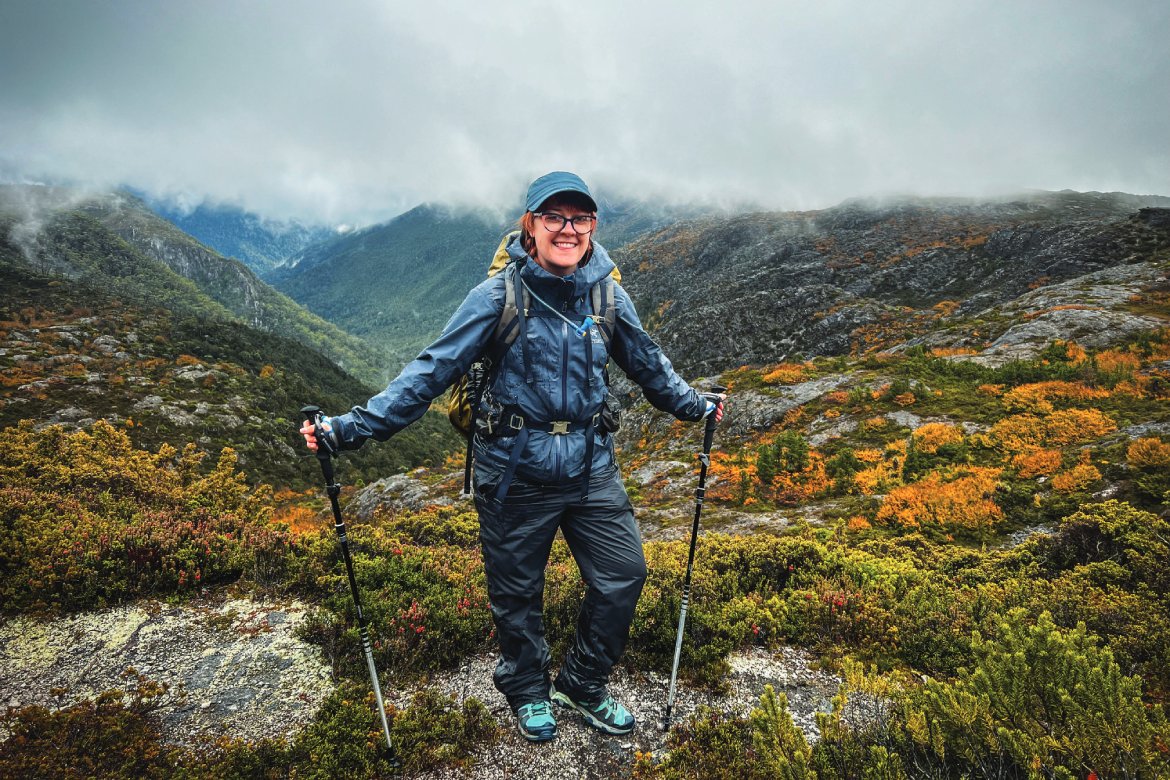
Emily Hiking through Overland Track Rain (Photo by Emily Pennington)
With the dollar at a high point and Tasmania off the radar of so many Americans (who veer more towards Melbourne, Sydney, and Perth), this tiny island state to the southeast of the main continent is a perfect blend of other Oceania destinations. It’s relaxed and unpretentious, boasting a phenomenal foodie and art scene, loads of majestic national parks, and it even has opportunities for day trips to penguin viewing areas (no pricey cruise to Antarctica required). Plus, it’s less expensive and touristy than New Zealand, even though it’s host to a similarly rich landscape.
Tasmania, which started off as a penal colony in the early 1800s, was once shamed for having a terrible human rights record, but it has since transformed into a bastion for queer, indigenous, and liberal folks of all stripes, in spite of its remote location. Visit in February if you want to get in on TasPride (taspride.com) and The Tasmanian Queer Woodchop Championships (discovertasmania.com.au/experiences/stories/lgbtqia-festivals-and-events).
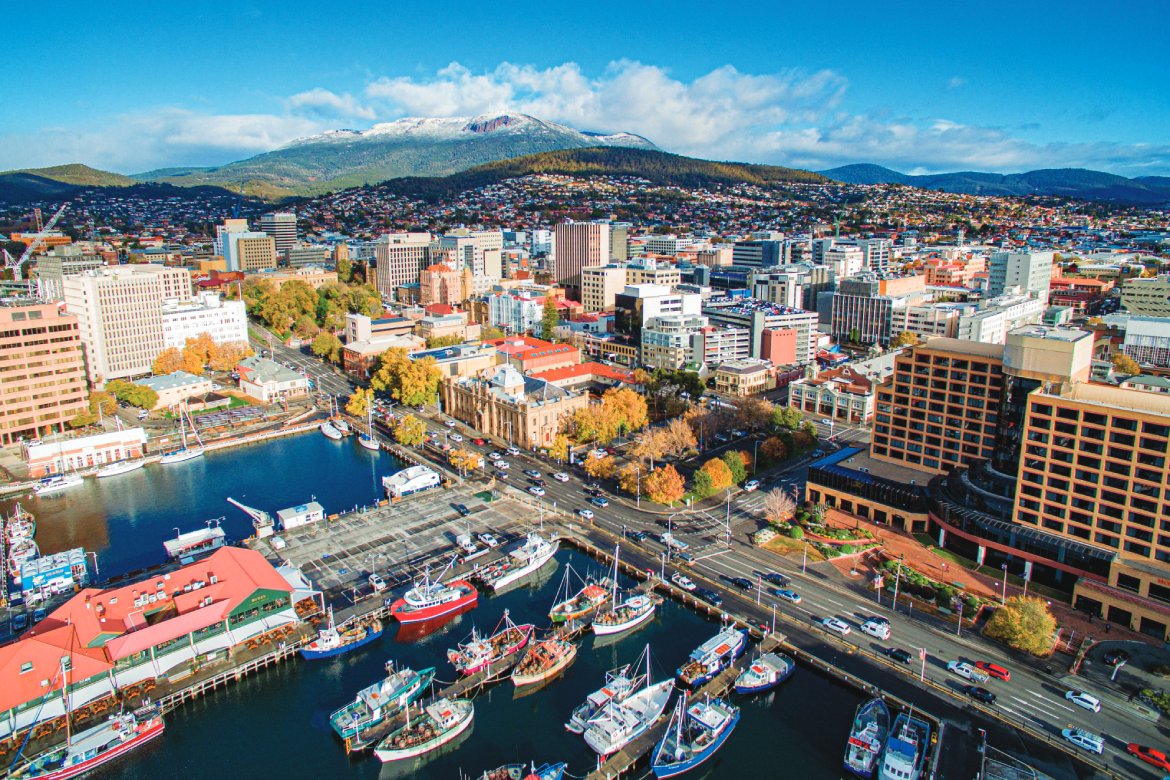
Hobart Tasmania (Photo by Angry Bird Productions)
During summer in Tasmania (December through March), the state truly comes alive, particularly in its capital city of Hobart, by way of drool-worthy farmer’s markets in Salamanca Place (salamancamarket.com.au), free live music in public parks, and the illustrious MONA FOMA (mona.net.au), a deliriously quirky arts and music festival held each February.
My journey to Australia’s oft-forgotten island state began in the slightly less crowded and cooler month of April, with an afternoon “chocolatology” happy hour at the new Mövenpick Hotel (movenpick.accor.com), where I was staying. Every afternoon from 2 – 4 P.M the hotel and their expert chef curates a special mix of cream puffs, truffles, egg-shaped candies, and layered pastries for guests to indulge their sweet tooth (and, yes, it’s included in the regular room rate–yum). I quickly learned that, with so many local producers of cheese, seafood, baked goods, and wine, Tasmania takes its food scene very, very seriously.
Afterwards, I took a short stroll down to Hobart’s colorful waterfront to work off my high-calorie afternoon snack. While there, I perused the many ice cream and fish and chips stands, making mental notes for future meals.
That night, it was time to sample Möven pick’s chef-driven in-house restaurant, Tesoro (tesorohobart.com.au), which prides itself on delivering fresh, locally-sourced modern Italian fare to discerning diners. Head chef Glen Tilly ensured that I feasted on the freshest salad, squid ink orecchiette pasta, and a special hot cross buns-inspired ice cream dessert, which made my mouth water.
As my time in Hobart continued, I became more and more thankful that I’d be capping my trip off on the aforementioned Overland Track, which promised to work me back into shape after an indulgent few days in the city.
As I ate my way across Hobart’s incredible food and market scene, I learned about the state’slush agricultural regions, fresh seafood, local wineries, and whiskey distilleries. At Peppina (peppinarestaurant.com), my tastebuds were tempted by an incredible mixologist-crafted cocktail menu and warm, homestyle Italian cooking (try the Pesce del Giorno and the Burrata for an ultra-fresh, locally-sourced meal).

Fico Hobart Fresh Tasmanian Oysters (Photo by Emily Pennington)
Fico (ficofico.net), located in the city’s vibrant center, wowed me with its world class food, rivaling many of the Michelin-starred spots I’ve been lucky enough to visit in the U.S. And, like most restaurants in Tassie, its menu was nearly all based on local meats and produce. I dined well into the night chatting with my phenomenal server, who had a near-encyclopedic knowledge of whiskey and wine, as I salivated over long spine sea urchin, freshly-caught Kingfish (a staple in southern Australia), mushroom tagliatelle, and buffalo milk gelato with dollops of raspberry puree.
Perhaps my most memorable dining experience in all of Tasmania was on my day-long visit to Hobart’s famed MONA (Museum of Old and New Art; mona.net.au), the largest privately-funded museum in the Southern Hemisphere. Founded by professional gambler-turned-art collector, David Walsh, MONA is hailed as an art museum for people who don’t like art museums, “a temple to secularism and rationalism” that was once nicknamed The Museum of Sex and Death. Apart from its fabulous and irreverent collection of art, antiquities, and even the ashes of Walsh’s own parents set upon a gothic-style bookcase, MONA houses several fantastic restaurants and an outdoor music space where tourists and locals alike can lounge under the sun on huge bean bag style chairs.
With the weather being warm when I visited, I decided to sit outside at The Source Restaurant, which touts seasonal upscale-casual Tassie dining in sincerely elegant digs. My table was a literal live garden, plants sprouting up from a supportive metal frame, and I was instructed to simply place my drinks and silverware onto the loamy, uneven surface like a forest fairy. I passed on the Wallaby Takati and opted for the Tongola goat curd and Comté souffle, which came atop an herb salad. The rest of the afternoon was spent in a state of awe and wonder, spiraling through the museum’s three underground stories of immersive and evocative art (think entire rooms dedicated to spider-spun sculptures, a wall full of realistic molded vulvas, and moving fountains that spit out uniquely Anthropocene bits of language). I had no idea how Tasmania could possibly top itself after sending my mind spinning for so many hours.

Nunami Sculthorpe-Green Founder of Blak Led Tours (Photo by Emily Pennington)
Yet, on the very next day, I was greeted by a phenomenal woman named Nunami Sculthorpe-Green, who recently founded Blak Led Tours (blackledtours.com), a city and bush walking tour company developed to reclaiming and reinvigorating Aboriginal histories within the Hobart area. Sculthorpe-Green, who is of indigenous descent, is one of many activists working hard to bring Native stories to the forefront again, after the Australian government wiped out nearly the entire Aboriginal population across the massive continent. Tasmania, as a state, was hit the worst, and she detailed the region’s sordid past on my hour-long takara nipaluna (Walking Hobart) tour. Ever the busybody traveler, I shuttled down to putalina (Oyster Cove) immediately afterwards for Sculthorpe-Green’s newly-launched nature walking trip, titled mumara patrula, or Wood for the Fire, which centered a more poetic narrative onto the wild bush landscape as we traversed an easy coastal trail.
Though the food and cultural scene around Hobart was truly spectacular, I couldn’t leave Tasmania without exploring one of its main touristic draws, its hundreds of miles of hiking trails through lush rainforests, rocky alpine valleys, and unique buttongrass plains. I teamed up with Tasmanian Walking Company (taswalkingco.com.au), the premier guiding service in the state, for the area’s most famous multi-day hut-to-hut trek, The Overland Track.
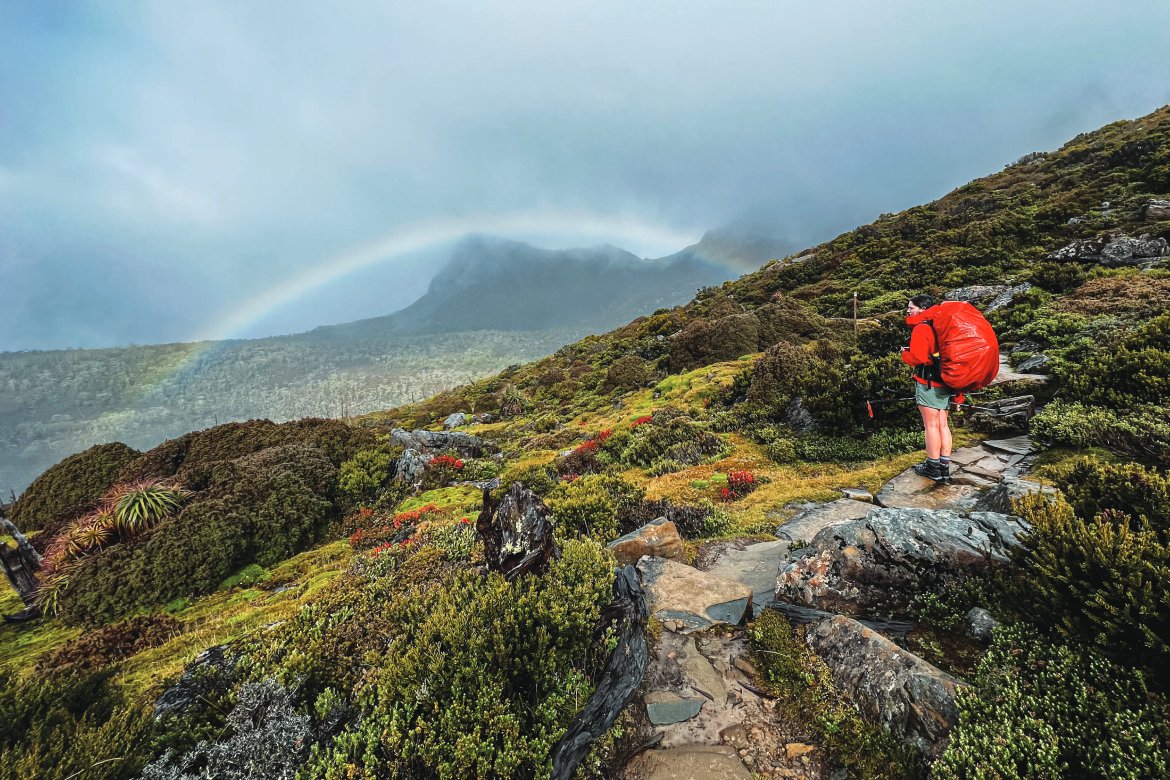
Hiking Guide Near Mount Ossa (Photo by Emily Pennington)
Suddenly, on the steep, craggy slopes of Mount Ossa, the sky opens up like a gift from the divine. On cue, a vibrant, perfectly-arced rainbow appears and my mind swoons, remembering all of the magical, otherworldly moments my eleven-day journey has dealt up to this point.
Unlike most hikers who travel from across the globe to walk the fabled Overland Track and sleep in crowded, government-subsidized huts each night, my group would be staying in privately-owned group cabins, eating three square meals a day prepared for us by two knowledgeable guides, and not having to shoulder the extra weight of our food, sleeping bags, and inflatable pads (thank goddess).
My trek began at the quaint and historic (albeit a little drafty) Red Feather Inn (redfeatherinn.com.au), a former carriage house turned bed-and-breakfast that serves as the home base for Tasmanian Walking Company, just outside of Launceston. After a delectable dinner and an early bedtime, I rose at dawn for much-needed coffee and pastries before meeting my plucky and fearless guides, Daniel and Maddie, for a morning gear shake-down. They sorted through my thermal layers, hiking clothes, rain jacket, and trekking poles, making sure that I had the required equipment for a safe six-day journey, then I loaded onto a large bus with ten other aspiring Overlanders, and we were off.
We got tossed into the deep end of Tasmania’s famously mercurial weather right off the bat, with hellishly strong winds and temperatures in the low 50s, which would have been fine if it wasn’t also raining for hours on end. Thankfully, our group had several opportunities to enjoy the area’s temperate rainforest, dipping our water bottles into a pristine rushing waterfall and admiring the glorious fall colors. Every year, typically in late April and early May, the country’s only winter-deciduous tree, the fagus, turns its ordinarily green leaves to hues of tangerine and crimson, before dropping them for the season. “The turning of the fagus” is a big deal to Tassie’s locals, and people from across the small state will drive up into the mountains to witness their phenomenal transformation. Though the name might conjure up a snaggle-toothed Harry Potter villain, the rapidly-changing trees, up close and in person, are simply gorgeous.
Still, far-off visibility was poor, and as we crested the steep stone steps to Marion’s Lookout, our guide Maddie said what everyone was thinking. “Well, usually you would have a pretty awesome view of Cradle Mountain and Dove Lake from here, but it’s all covered in clouds.” We hiked on to Kitchen Hut, where we enjoyed a brief respite from the howling winds as we ate our sack lunches.
Thankfully, Tasmanian Walking Company has worked with the park service to provide the only private lodging along this historic path, which meant that, rather than bedding down with dozens of strangers and hauling a full week of food and kitchen gear, we’d have the pleasure of home-cooked meals and fireplace-heated group cabins that evening. Daniel, our other guide, ran ahead of the group as we suffered through the final hour and a half of frigid wind and rain.
When we arrived, a fire crackled in the common area, hot water was ready for afternoon tea, and a drying room stood at the ready for us to hang our sopping wet clothes, backpacks, and boots. Dinner, we were told, would skew more vegetarian as the trek soldiered on, and more dry goods would be consumed, but on that first night, we feasted on roasted salmon with quinoa and homemade cabbage coleslaw. After a memorable dessert of orange fudge and fresh strawberries, I wandered to my bed, tucked into my sleeping bag, and fell asleep reading, and praying for better weather.
First, the bad news: better weather did not arrive for a few more days. And, though I was heartbroken that I’d miss the phenomenal views of Barn Bluff, Lake Will, and craggy Mount Oakleigh, the horrendous weather and mud-soaked trail made me slow down, get Zen, and appreciate the little things that were right in front of my face, no big, postcard-style vistas necessary.
The good news: I spent the next two days swooning over the light, golden amber of seemingly endless buttongrass plains and hopped from root to root in the trail’s many dense rainforest sections, reveling in the opportunity to photograph fall’s newly-sprouting mushrooms in a sort of fungi safari. Colorful, capped bodies with evocative names like strawberry bracket fungus, green stem pinkgill, and myrtle orange (which is edible when fully ripe in the summertime) seemed to sprout out from every moldering stump and moss-cloaked log. My favorite? A delicate strain that glowed azure blue in the daylight–pixie’s parasol.
“Don’t even try to have dry feet today,” Daniel muttered at the top of day three, “This is going to be a particularly wet, muddy, and rooty day, and going around the many puddles just hurts the plants and creates erosion. Oh, and one of the mud puddles is nearly waist height, so try not to fall in that one.”
“Yikes,” I thought to myself as I donned my rain gear. Even with the weather remaining dreary for the first four days of the six-day hike, our trekking group stayed in good spirits and perhaps appreciated the creature comforts we found in the shared mountain huts even more than we would have if the sun had been shining. We drank tea with freshly baked scones for afternoon snacks and supped on guide-prepared dinners of beetroot ragu and Indian curries.
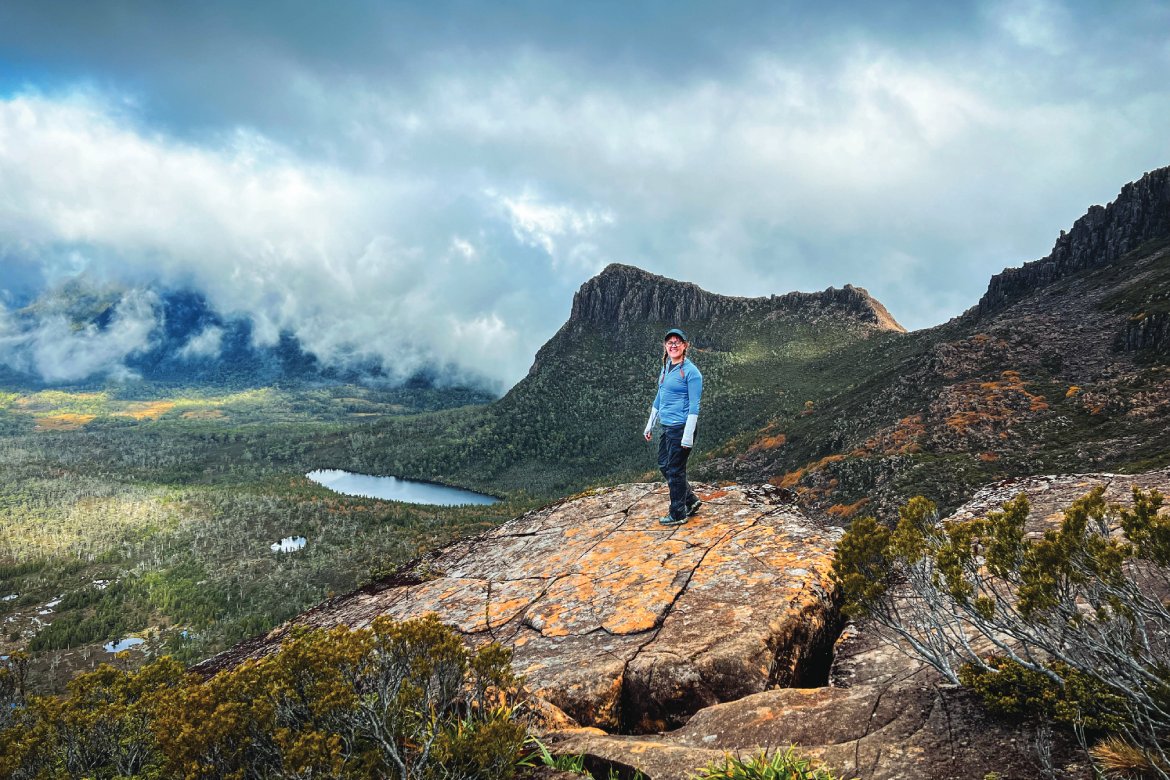
Emily On Ledge Near Mt Ossa (Photo by Emily Pennington)
With so much of my attention pointed face-down towards the trail’s smaller details, I almost missed my chance to summit the highest peak in Tasmania, Mount Ossa, on day four. Gray clouds loomed low when we neared Pelion Gap, the junction for the summit side trip, but Maddie was brave and said that she’d happily try to climb the mountain with whoever wanted to venture forth. I thought of the famous Kerouac quote, “In the end, you won’t remember the time you spent working in the office or mowing your lawn. Climb that goddamn mountain.” So, off I went.
Three other intrepid souls joined as well. Our fivesome of rain soaked hikers began to ascend hundreds of feet of stairs through the bright orange fagus trees, noticing that, as we climbed higher, the clouds appeared to be lifting. Mount Ossa sits at a lofty 5,305 feet above sea level, roughly 1,500 feet above the turn-off at Pelion Gap. We meandered through a particularly scenic stretch of trail called the Japanese Garden, where neatly arranged stones lined the alpine path and the fagus trees faded from view. In their place, smaller and heartier high-elevation plants began populating the rocky landscape.
Up, up, up we climbed, sometimes hand-over-foot on large, uneven boulders. I huffed and puffed my way up the final few hundred feet to the summit proper, hoping to glean a triumphant view after so many days spent with my head down in the pouring rain.
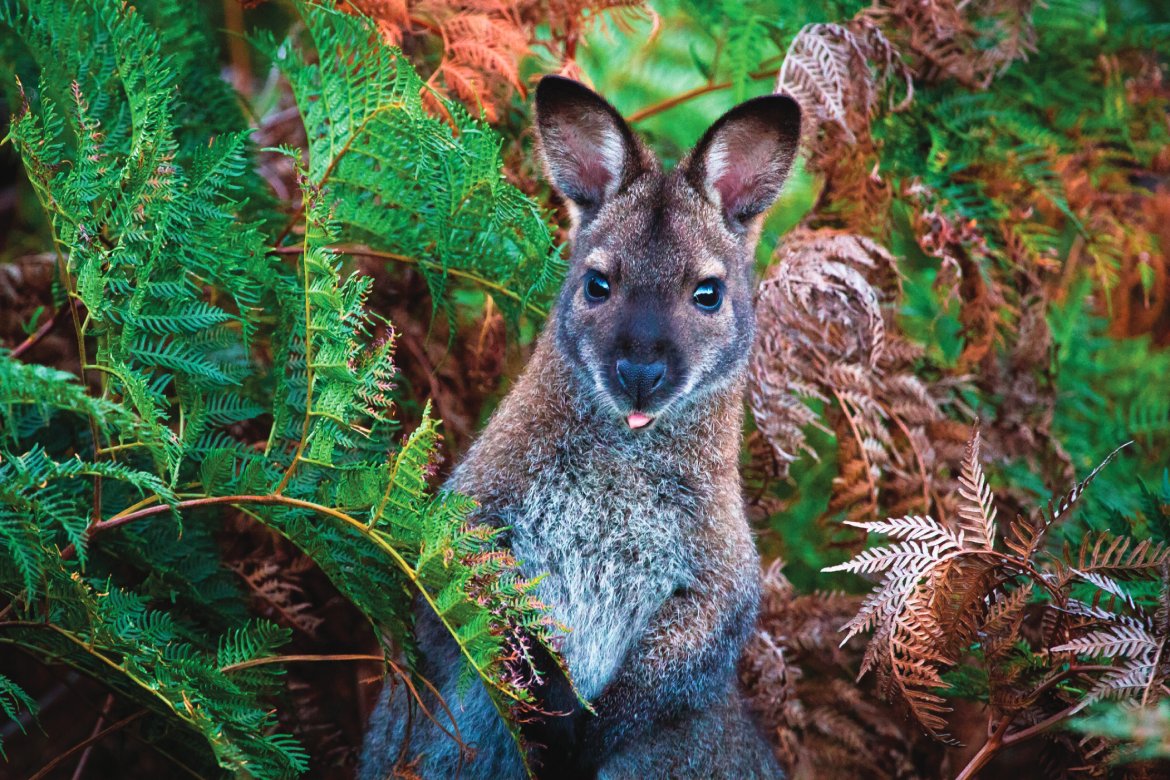
Red-Necked Wallaby (Photo by Kevin Wells Photography)
As if the gods of fate knew just what I needed, the clouds continued to lift, and my ferocious group of five was treated to a jaw-dropping summit vista from the very top. I had done it; I had summited the tallest peak in the state. A sense of awe and accomplishment washed over me the entire hike down and over my supper of mushroom and pea risotto that evening. It followed me into the remaining two days of perfect weather as I traipsed through forests thick with gum trees, colorful fungi, and tiny wallabies.
The entire experience was a potent reminder of just how much the occasional hardship on a vacation can serve to highlight the many simple wonders that surround us every moment of the day. I endeavored to carry this notion with me as I returned home and inevitably fell back into complacency and routine: the idea that contrast will brighten the dullest of days. Difficulty begets gratitude for what already is.
I’ll forever be bowled over by Tasmania, the heart-shaped island where rain meets land.


